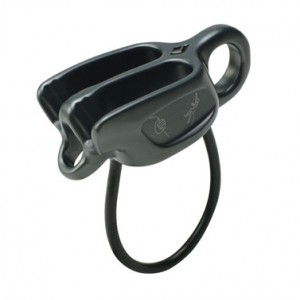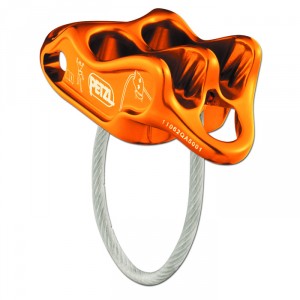Use this guide as a general assessment for ways to belay a seconding climber from above. Remember, learning about rock climbing online serves as a tool, but in no way are written articles a substitute for hands-on instruction. Failure to follow appropriate safety measures could result in serious injury or death. If just getting started, seek professional climbing courses offered by AMGA-certified guiding services. Be smart, and climb safe.
Introduction
When arriving at the top of the climb, a leader is faced with multiple options for belaying up his/her follower. The classic method for belaying from above has involved a belay direct from the leader’s harness and redirected through the anchor. But, some argue that this is the “old” way to belay from above, and instead recommend using guide mode on an auto-blocking belay device — such the Black Diamond ATC-Guide and the Petzl Reverso.
Regular ATC vs guide mode ATCs:
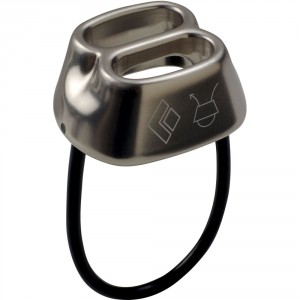
Black Diamond ATC
(not usable for guide mode)
Redirected belay
In a redirected belay, the belayer clips the rope that leads to their partner into a carabiner or quickdraw attached to the anchor above the waist. The belayer then attaches this rope to the belay device on their harness. In this scenario, the belayer holds part of the weight during a fall and the anchor bears both the belayer and partner’s weight; creating a 2:1 force on the system.
Pros:
- Quick, easy to set up
- Does not require owning a guide/reverso-style ATC
- Can be easier for beginners familiar with clipping belay device directly to harness
Cons:
- Places more force on the anchor (2:1)
- If follower falls, belayer can be pushed into anchor; compromising belay
- More difficult to escape the belay
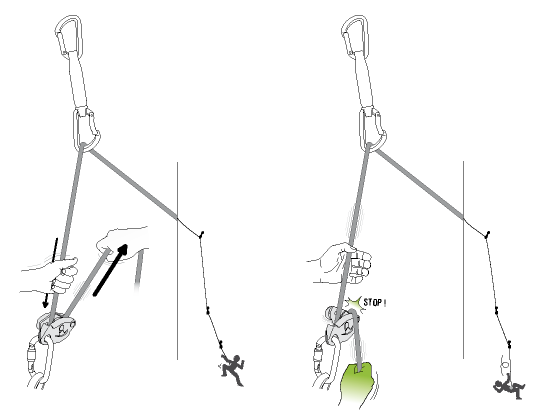
The setup of a redirected belay. Image: Petzl
Related: The Delicate Dance of Multi-Pitch Passing
Guide mode belay
When belaying with guide mode, the ATC-Guide or Reverso (not a standard ATC) is configured directly onto the anchor. In the event of a fall, the weight is transferred at a 1:1 ratio of force onto the system—which bears only the climber’s weight.
Pros:
- Applies less force on the anchor (1:1)
- Stress is not on the belayer’s body in the event of a fall
- Can provide more comfort because the system is not directly attached to the belayer
- If belayer drops belay, falls unconscious, etc. the device will auto-block the rope and catch a climber in event of a fall
- It can be easier to escape the belay; belayer is not part of system
- Easier to belay two climbers simultaneously
Cons:
- Requires owning a guide-ATC device and additional locking carabiner
- Can be uncomfortable to belay at waist level or below (see video below)
- Slower when trading leads, as belayer must re-adjust belay directly to harness
- More difficult to lower, if necessary
The benefits of guide mode, outlined in this video:
How to belay in guide mode
When building your anchor to belay in guide mode, you’ll want to ensure that you have enough distance to comfortably belay your partner. Ideally, your master point will be above waist level. After pulling up the rope from your seconding climber,
- Clip a locking carabiner into the large metal loop on the device, attach to the master point of your anchor, and lock the gate of the carabiner.
- Insert a loop of rope into the ATC’s opening; keeping the climber’s end of the rope on top (this essentially pinches/locks the brake strand on the bottom in the case of a fall).
- Take another locking carabiner, and clip the rope loop and the belay device’s cable, and lock the gate shut.
- Before belaying, tug on the climber’s rope to ensure you have positioned the rope correctly. You should feel the auto-locking capability.
- To begin belaying, feed rope up through the device with one and while simultaneously pulling down with your braking hand. In the event of a fall, the device will lock.
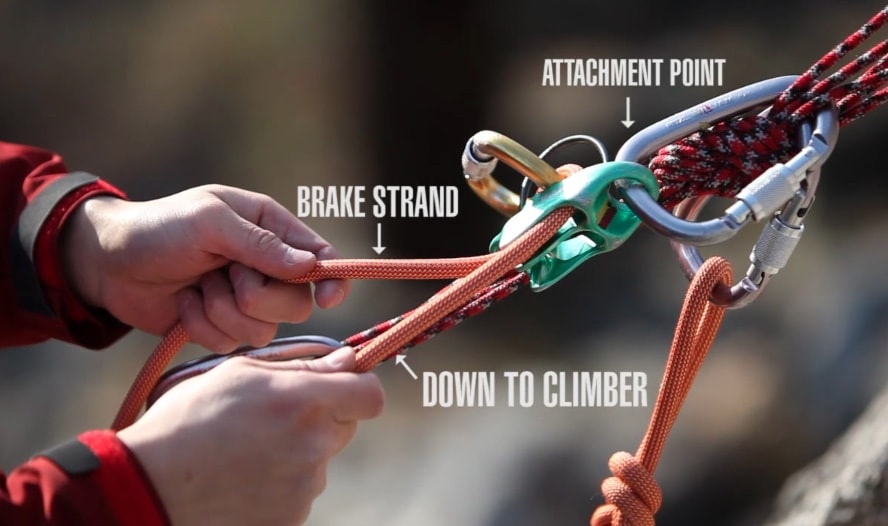
Related: Anchor Building Tips from Hans Florine
Final safety checks before belaying
Before belaying your partner in a multi-pitch situation, always remember that no one is there to double check other than you. This means you must do your due diligence of ensuring your and your partner’s safety! Before you belay from above, always ask yourself …
- Am I secured by at least two solid points on the anchor?
- Have I locked all locking carabiners in the belay system?
- Is the rope fed into my belay device in the correct position?
Watch a step-by-step look at a multi-pitch, including how to swap leads after the belay:
Summary
While you can elect to belay from above using a redirected belay, many climbers consider the guide mode functionality as the superior choice. The primary safety benefits are that it:
- Applies less force on the anchor (1:1)
- Auto-blocks the rope in the event of a climber falling
- Is an easier system if needing to escape the belay
Deal Alert: This week’s best on-sale climbing gear
Want more climbing content? Get our awesome climbing newsletter, delivered weekly.
Explore more
- Top 25 Best Books for Rock Climbers
- Climbing Rope Management During Rappel
- Free Rock Climbing eBooks on Technique, Knots, Training, and More
- How to Build a Trad Rack
- Gear Guide: The Best Rock Climbing Shoes
- Van Life: Essential Gear for Dirtbagging on the Road


